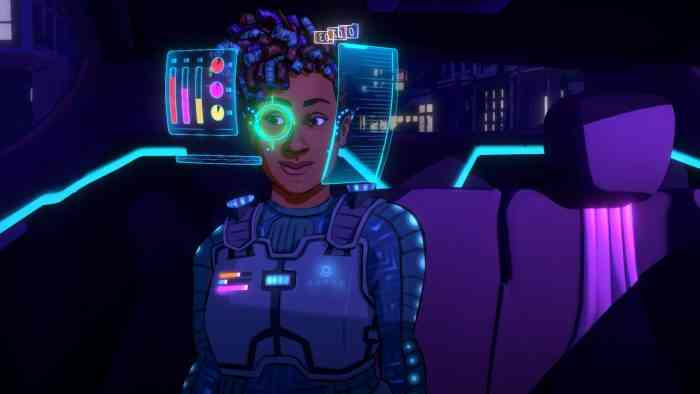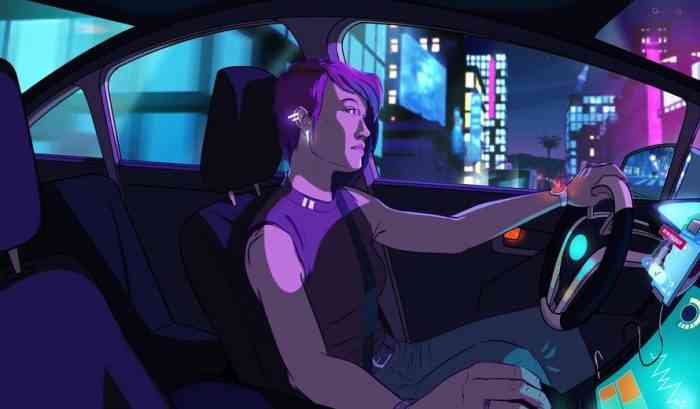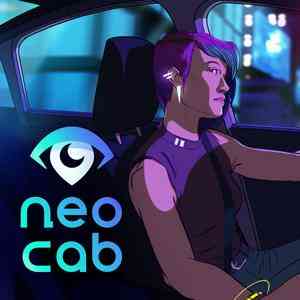Neo Cab Review
As you focus on the road ahead, a mysterious lady in the backseat of your Neo Cab rambles on about her views on reality and its numerous possibilities. “The universe is made of infinite timelines, always branching based on the tiniest decisions, is perfectly coherent and stable…” she reveals. As you talk, your Feelgrid bracelet flashes different colors, openly displaying your feelings, allowing you to honestly express yourself. Eventually, the ride comes to an end. Oona St. Clare bids farewell to you, Lina, one of the few human drivers left. You grab your phone to check both your rating and how much money you’ve made. Good. Just another night in Los Ojos, onto the next pax.
Neo Cab is a single-player branching narrative game about humanity… And the pitfalls that come with it. Peeking not too far into the future, this is a world where human drivers are a rare specimen. Automation has taken over and all of the problems we witness in 2019 are either the same or intensified. The influence of corporations over peoples’ lives, obsession over social media, and polarizing opinions are just a few of the themes. It all seems very bleak and Black Mirror-ish, but the way in which the game tells its story is quite empathetic with a strong emphasis on its cast of characters.
Starting with the protagonist, Lina. You are a Neo Cab driver, the remaining rideshare company that still employs humans. Capra, on the other hand, is the norm and has its automated cars roaming the streets of Los Ojos. To some passengers, it might feel safer to ride with a machine, but to others, driving with another person is the chance to connect. Which is what brings you to the city.
Mr. Cab Driver Don’t Like The Way I Look
Lina drives to Los Ojos to meet Savy. However, when her longtime friend goes missing, the only thing Lina can do is roam the streets in search of pax (the term used in Neo Cab future for “passenger”). Despite the constant driving, this is nothing close to a “driving game”. Mechanically, Neo Cab is much closer to a visual novel. You are never really in control of the car, but rather of the conversations. The story progresses as you make choices that are mostly comprised of dialogue lines with diverse passengers. And quite diverse they are.
Be it talking with cult members, protesters, quantum witches, tourists, photojournalists or even witnessing a weird in-car date, Neo Cab has you live Los Ojos through the chronicles of its inhabitants. Every pax dialogue is a short story on its own. While Where The Water Tastes Like Wine had its folktales, Neo Cab’s pax are its vignettes. The challenge is talking your way (literally) through these scenes and earning good ratings for each ride. This requires you to interpret the character’s personalities and predict the best dialogue options. Otherwise, you might get several low ratings in a row and lose your Neo Cab license.

The novel mechanic here is you wear a Feelgrid bracelet and it directly influences the dialogue choices you make. The rationale behind it is that this piece of technology reads your biometrics and displays your feelings as colors. If you’re relaxed, you’re green; sad, blue; excited, yellow; and angry, red. The concept is intriguing and the feeling of getting extra dialogue choices based on Lina’s emotional state adds a welcome layer of player expression. Not by chance, the game had a team with several writers responsible for these different encounters.
The problem is at times both the reactions of passengers and the changes in emotional states can feel arbitrary. You might do your best to please a pax only to receive a horrible rating at the end and not understand why. You might see Lina get mad at a comment and not be able to select on-screen dialogue replies because they’re locked for representing different emotions than what Lina’s feeling at the moment. One could argue that’s how life works and the game is merely mimicking it. However, it does occasionally break the immersion and reveal the “rails” of the story because it doesn’t feel like a natural flow.
I’m Walkin’ Here
Aesthetically, Neo Cab does a good job when it comes to representing the cyberpunk vibe through its visuals and sound. The game sticks to its theme and shows its style in its interface, map and character renditions. The same goes for the synthetic soundtrack which offers several moody tracks to match the tone of the scenes. Still, after so many hours playing, the pacing can get a bit monotonous. The visuals of the streets never really seem to change – despite the textual descriptions indicating otherwise -, the repetition of the tracks becomes noticeable, and the story drags a bit.

Neo Cab approaches the premise “What if I were a cab/rideshare driver? What stories would I hear? What would that play like?” and takes it a step further to a speculative dire near-future. Despite its dark themes, there is a quirky charm in its several dialogues and the game does a fine job of debating relevant societal issues. If you’re into visual novels, then you’re used to doing lots of reading and advancing through simple interactions, which is exactly what Neo Cab offers. As a branching narrative game, your choices are perceived by the system. It feels good to have an impact on the story, but the focus here is clearly on connecting with people and affecting their lives. After all, one could say “Isn’t that what life is all about?”
**A PC review code was provided by the publisher**
The Good
- Interesting Emotional Dialogue Mechanic
- Diverse Writing Styles
- Moody Soundtrack
The Bad
- Monotonous Pacing
- Restrictive Dialogue Options
- Lack of Visual Diversity

